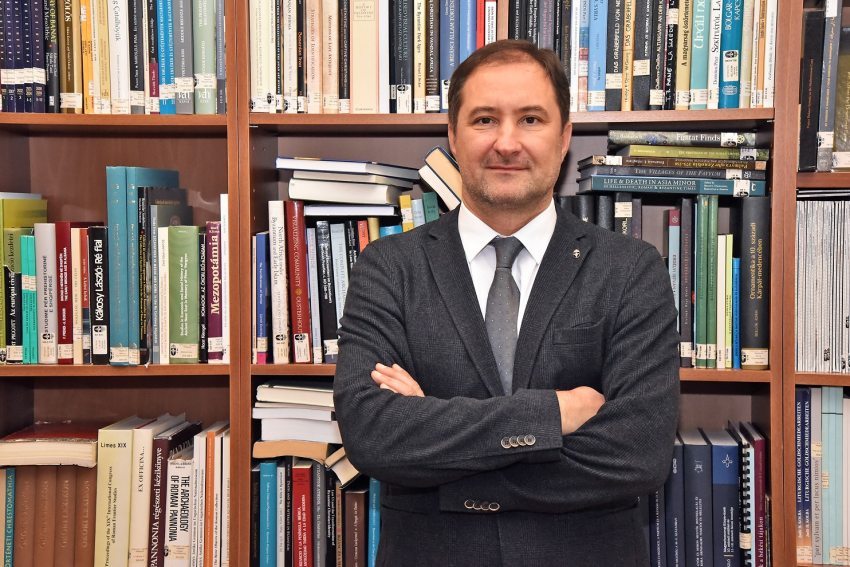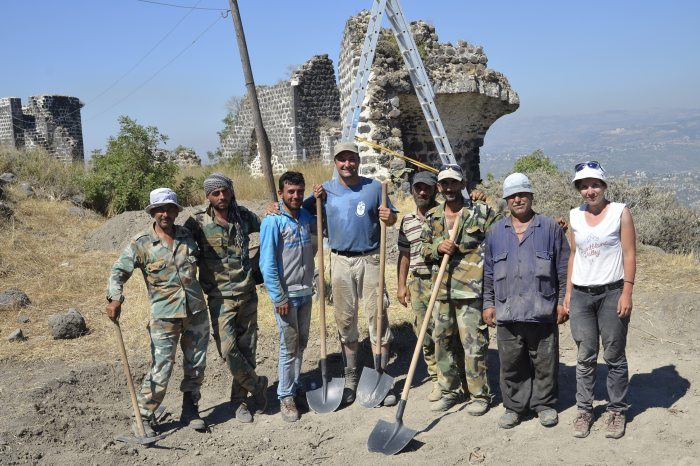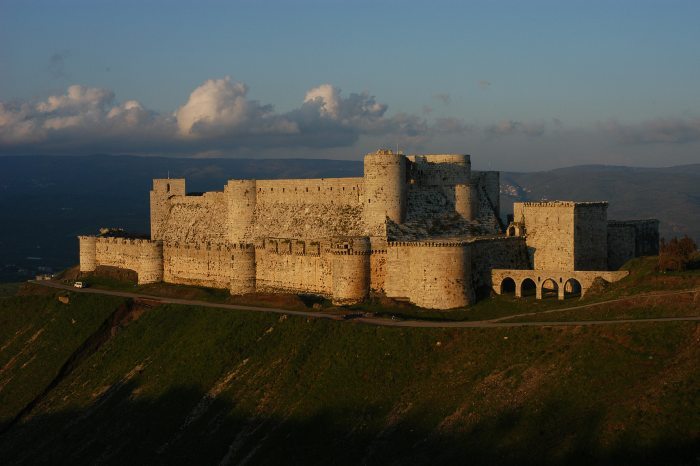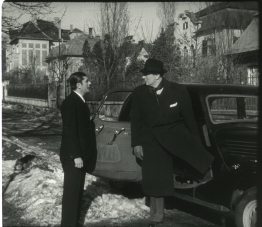Discovering the largest crusader mural cycle in the Holy Land – Hungarian archeologists are at least as good as their Western colleagues
By fulfilling his childhood dream, he not only gave his life a purpose, but his work resulted in a university course and institute, too. Balázs Major, head of the Department of Archaeology at Pázmány Péter Catholic University, has been researching the legendary castles of the Crusaders for more than 20 years, and in the course of his work Hungarian experts have made several world-famous discoveries. They have discovered the largest mural painted by Europeans in the Holy Land and a large Crusader city that nobody knew existed.

How long have you been researching knight's castles?
I have always been interested in the Middle Ages, especially the 12th and 13th centuries, especially the castles. One of the reasons for this is that when we lived in Miskolc, my parents and I often walked to Diósgyőr Castle, near Miskolc. If you add the castles to the 12th-13th centuries, you soon get the result: the Gothic period, chivalric culture, and crusades. Growing up, I also realized where all this manifested itself most: the Middle East.
What were you the most interested in about the mixed, European-Levantine culture that had developed there?
Most of all the daily life of a European colony of about a quarter of a million people. For almost two hundred years, the four crusader states were home to soldiers and civilians, family members who had emigrated from the old continent.
Speaking of numbers, what was the proportion of the local population compared to the European population?
It is estimated to be about ten times higher.
The question arises: how have different cultures managed to coexist throughout the centuries of constant warfare, at least according to history books?
First of all, the Principality of Antioch and Tripoli County had predominantly Christian inhabitants, and at that time Islamization was far from advanced in those areas, but it was also slow in many other areas. When Saladin (1137-1193) conquered Egypt in 1171, about seventy percent of the population in the land of the former pharaohs was still Christian. Of course, Islam was already present in the region, especially in Palestine, in the Akko region, but in the holy places of Bethlehem, Nazareth, and around Jerusalem, Christians were in the majority, as in the northern part of modern-day Lebanon and in the Syrian coastal areas as well. In the north, we find mainly people of the Shiite denomination, who were often persecuted by Sunni Muslims.
All in all, Christians and non-Christians understood each other very well.
Even in spite of the wars?
As Foucher de Chartres, one of the first chroniclers of the Crusades, wrote, "we are slowly forgetting where we came from", meaning that Europeans were rapidly assimilating. What must be seen is that it is impossible to look at that period from a completely wrong perspective, influenced by our own time and ideology. Who can read Arab chronicles today? Who even wants to, when so many documentaries have been launched and so many books published on the subject? Most people believe that this modern literature - written by Europeans - is not wrong, which is why today's generation rarely studies the Latin and Arabic sources of the time. The horizons that Western scholars used to embrace are rapidly narrowing.
Would the sources you mentioned paint a different picture than those published in the literature?
It is extremely important to be aware of all the sources because that makes it clear that we should not think of the Crusades as a constant day and night battle between the peoples living there, but sometimes twenty to forty years would pass in a given area without any military movement. Unlike in most parts of Europe. Going back to your original question, I was curious to know how the different Christian and Muslim denominations lived together since religion was the only thing that mattered then – and, let me add, still matters – in the region. Arab sources also show how peacefully European and Arab peoples of different religions lived together.
Could you give us an example?
Ibn Jubair, a Muslim official in Andalusia, who was terrified of traveling, drank alcohol once, despite his religion's teachings. Ashamed, he felt that only a pilgrimage to Mecca could atone for this mistake of his. How did he get from Andalusia to Mecca in the 12th century? By boat. The Mediterranean was then dominated by the Venetian and Genoese galleons, so if you wanted to travel cheaply and safely, you went to Alexandria on one of them, then by land, and then across the Red Sea to Mecca. In other words, a Muslim pilgrim to Mecca would get from one Muslim port to another by a Christian boat. But this is only the beginning. Although he did not like to travel, once in Mecca he decided to visit the surrounding sights. He went to Baghdad, Damascus, and from there back to Europe. On the way, he encountered Saladin's army returning from the north to Jerusalem with European prisoners and stolen treasure.
He was a little apprehensive about travelling further, as he had to pass through plundered Christian areas, but to his surprise, no one harassed him.
Again, the above-mentioned Arab traveler writes: when he stayed in a Sunni village, he was told by the locals that they were living peacefully under the Crusaders and had no problems with the Europeans. He even learned that foreigners collected fewer taxes than Muslims. They describe the Christian rulers there as just and good. Another thing: big European companies, mostly Italian, maintained depots in Aleppo throughout the war periods, including even the tiny town of San Gimignano, which monopolized the saffron trade in Europe. After driving out the Crusaders, the Genoese continued to have a colony in the city of Latakia for about 150 years and traded freely.
What motivated you in your research?
I like specific, tangible things, I am not the man to write a sixth book out of five. Of course, that doesn't mean I don't read or am not familiar with the relevant literature, I just want to emphasize the importance of my own field research. I was interested in how people lived in the past, how their everyday lives were, what memories have been preserved of their everyday lives, and where bridges, castles, and residential towers still stand. I was particularly moved by how people lived in the countryside. When I was a university student, I started to look for monuments in Syria, not only medieval ones but also Roman and Byzantine heritage. Unfortunately, the rate of destruction of monuments in the region is such that many remains are now only visible in my photographs.
If these structures have survived for over a thousand years, why are they disappearing in the 21st century?
On the one hand, many monuments were destroyed in the war, and most people care less about what happens to monuments when they have lost a family member or their home in the war. In peacetime, infrastructure development makes way for itself.
In Hungary, we are overjoyed with a knee-high castle wall, as most of our medieval monuments were destroyed by the Ottoman period at the latest, but in this region, even ancient monuments up to roof height are commonplace.
Where there are ten-story castles spread over several hectares, an investor rarely cares whether there is one more or one less residential tower left in the country, and where every square centimeter of farmland has a high value. We are past the twenty-fourth hour.
The Hungarian research you are leading is taking place in the castles of Margat and Crac des Chevaliers. Why are these Crusader castles significant?
By the 13th century, interest in the Holy Land had decreased at the European courts, but warfare had developed enormously and castles needed to be fortified. The crusaders sought to make up for the lack of manpower by improving fortifications. This was the era of the construction of these great fortresses, the like of which were not built in Europe at that time. The two forts mentioned are so large that they will keep researchers busy for decades to come.
What are the main results of the research programs?
I see their greatest significance in the fact that for fifteen years Hungarian experts have been working on the excavation of one of the world's most famous monuments. Even in Hungary, it would not be easy to maintain an excavation program for so long, let alone abroad. What's more, the work has led to the establishment of a university course. The success in Syria has led to the launch of an archaeology course at Pázmány University, which will make use of the professional knowledge and network of contacts we have built up over the years in Syria. Our former dean had explicitly requested that we incorporate this knowledge into the university's teaching. The Institute is up and running, with four departments. Half of our students are from abroad, mostly from Syria, through the Stipendium Hungaricum scholarship program. They will hopefully be re-employed later on in the protection of monuments and education in their own country.
What successes have Hungarian archaeologists achieved on the site?
We have fully mapped Margate, with only the inner Johannine castle covering one hectare, the settlement built within a defensive ring around it covering five hectares, and under the castle, we have identified an outer town with houses, churches, and a cemetery covering a further ten hectares.
The biggest achievement was to find out the function of almost all the rooms in the castle. This is not easy, even in the case of a small Hungarian castle, let alone a fortress system of this size.
We have also explored the castle's water management system, making it the only one of its kind in the Middle East.
Why is this last result particularly important?
We are in the Middle East, in a fortress built on a volcanic cone. We could dig, but we'd find no water. The entire fortress, the soldiers, the civilian population, the animals, and the baths, were supplied with collected and purified winter rainwater for a whole year.
You mentioned baths. It is widely believed that people rarely used to bathe in the "dark" Middle Ages.
We also discovered four baths for crusaders in Margat. The castle hill was full of drilled cisterns, where rainwater draining from the flat roofs was led by an elaborate collection system. Moreover, this system can be reused today, after eight hundred years. In today's world, what is more precious than water in the Middle East? When we were asked to find a way to drain the wastewater from tourist toilets, we found old sewers that we could clean and reuse by laying modern pipes. Among the results, I would also mention the discovery of the aforementioned ten hectares of outer town, where a complete bathhouse was also located.
Is there no mention of it in the written records?
Unfortunately, there are hardly any sources about the huge Crusader fortresses, and the few sentences about Margat that do exist, do not mention the outer city. While surveying the hillside, we discovered human bones sticking out of the bush-covered wall. Looking further afield, we came across fragments of Crusader pottery, and then a silver denarius from Tripoli and a fragment of a fresco. All these suggested that the site had been a funerary chapel, so this was high on the excavation agenda for the following year. We found a complete cemetery from the Crusader period, the remains of the chapel and twelve dwellings. Another summer I noticed a white arch spire, also emerging from the bush a few hundred meters away. Here we were able to identify a two-bay church and uncovered the remains of elaborate wall paintings.
Was there a discovery that you considered to be a "worldwide " success?
All of the above, but the one that made it into the New York Times is a huge fresco that our restorers uncovered in the church of the Margat Castle. The church wall had been researched before, but in 1980, American-British experts concluded that the geometric lines they had discovered could only have been part of an underpainting. This led to a study that suggested that the appearance of Saladin in the Middle Ages may have caused the work to stop. Well, it did not.
We brought Hungarian experts there, who found huge frescoes in the first summer, and in the apse, they also discovered that there were several layers of wall paintings on top of each other. This is how we discovered the largest Crusader mural cycle in the Holy Land, the largest part of which depicts Hell in three registers.
A very large arsenal of weapons was also found, probably gathered by the Muslims after the siege of 1285. All this proves that Hungarian experts can achieve the same results as their Western colleagues.









